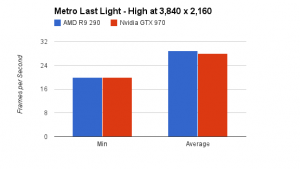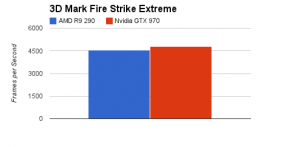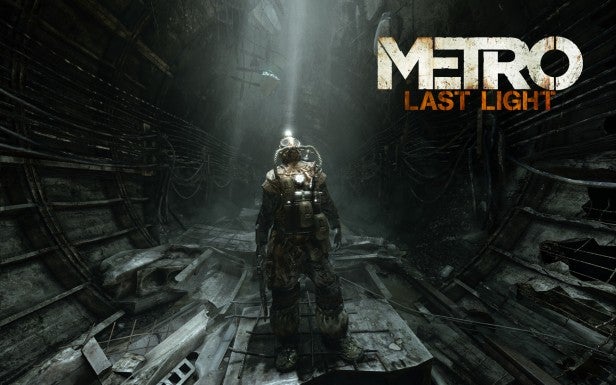Nvidia GeForce GTX 970 v AMD Radeon R9 290

Nvidia GeForce GTX 970 v AMD Radeon R9 290: Metro: Last Night Performance
Metro’s benchmark returned consistently low framerates when we tested both cards, with most running in the late teens despite much higher average results elsewhere. It’s likely that these scores are caused by anomolous frames, and they’re nothing to worry about – they’ll manifest as tiny stutters and sometimes won’t even be noticeable.
That’s especially true at 1080p, where both cards comfortably beat 60fps with their average framerates. The GTX 970 took the lead with its 67fps result, with the R9 290 two frames back.
Neither card had much difficulty at 1440p, either, and Nvidia’s card still topped the table: its 56fps average remained two frames ahead of its rival.
Metro’s demanding graphics were too much for both cards to comfortably handle. Both shared a minimum framerate of 20fps, which will cause noticeable stuttering during gameplay – cold comfort for the AMD card, which averaged 29fps and beat Nvidia by a single frame.
AMD takes that last test by a whisker, but it’s still not enough to render Metro playably at 4K. In tests where both cards returned playable results, Nvidia won by a couple of frames each time.
WINNER: Nvidia



Nvidia GeForce GTX 970 v AMD Radeon R9 290: Synthetic Benchmarks
These tests use modern engines and demanding test scenes to evaluate the raw horsepower of cards – handy for seeing just how much power is available across both GPUs.
The status quo remained intact in 3D Mark’s high-end Fire Strike test. Nvidia’s GTX 970 returned a score of 9,567 in the 1080p-focussed standard test, with the R9 290 lagging behind with 9,379.
The next test, Fire Strike Extreme, evaluates high-end systems designed for 1440p gaming. The GTX 970 scored 4,800, while the R9 290 hit 4,544. We ran the 4K-focussed Fire Strike Ultra test, too, even if it’s something of a moot point; Nvidia’s card scored 2,446, while the R9 290 scored 2,435.
The Unigine test is an intensive benchmark that’s designed to push GPUs to their limits. AMD’s card took a surprising lead in the 1080p benchmark, where its 51fps average outpaced the 50fps scored by Nvidia’s card.
The R9 290’s 31fps maintained its one-frame lead when we ran the test at 2,560 x 1,440, and it was one frame ahead in the 4K test too – although the R9 290’s 14fps average isn’t going to set the world alight.
Nvidia’s card took the lead in the 3D Mark benchmarks, while AMD fought back in Unigine. It’s a tie.
WINNER: Draw




Nvidia GeForce GTX 970 v AMD Radeon R9 290: Power and Heat
Maxwell’s improved power efficiency help the Nvidia card to a convincing victory in our peak power draw benchmark. When our test rig ran with the GTX 970 stress-tested it consumed 262W – over one hundred Watts less than the R9 290, which contributed to a power draw of 367W when we ran the same test.
When idling the GTX 970 rig required 83W from the mains. That’s more than the 79W used by the R9 290-equipped system, but the difference between the two is negligible.
The Maxwell architecture didn’t just cut down on power consumption – it proved cooler, too. When idling the GPU’s 40°C temperature was four degrees chillier than its rival and, when stress-tested, the GTX 970 topped out at 76°C. That’s much more palatable than the 94°C top temperature of the R9 290.
There’s a cooler-related caveat that needs to be added to the heat results, though, because heatsinks make a huge difference to heat dissipation. Our R9 290 is an AMD reference sample, and those cards aren’t renowned for having great coolers – whereas our GTX 970 came from a board partner, and it had a chunkier heatsink that promised improved cooling capabilities.
Despite the improved cooler, there’s no denying the GTX 970’s impressive heat results. Those power consumption numbers don’t lie, either: Maxwell is far more efficient than the R9 290’s Hawaii architecture.
WINNER: Nvidia





